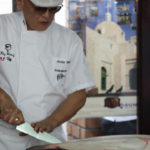The rise of Peruvian food has been unstoppable force since it first walked out on to the international food stage back in 2011 with famous Spanish Catalan chef, Ferran Adrià, saying that Peru held the key to the future of gastronomy. At the end of 2013, the cuisine of Peru was given another boost of credentials with world-renowned super chef, Alan Ducasse suggesting that Peruvian food has become one of the leading actors on the global culinary scene.
The positive flow of publicity for Peruvian food continued with the Culinary Institute of America announcing that 2014 would be the year of food from Peru.
With all this in mind, you might be wondering what to eat during your South America vacation in Peru and remember if by the end of this article you decide you want to try any of these dishes don’t forget to mention it to your travel specialist who will be able to help recommend some great restaurants throughout Peru! To start you off, we’ve made a list of our top 5 things to eat in Peru so that you can be sure to discover the food culture and beauty of Peruvian cuisine.

♦ Ceviche
The most well-known dish on the menu of Peruvian restaurants, ceviche has become so popular that it is set to land on the shelves of supermarkets in the not so distant future.
The new ‘sushi’ on the block, ceviche is a delicious and fresh dish which will take your taste buds on a journey like no other!
Marinated in a ‘tiger’s milk’ of citrus, chili, black pepper and onions the fresh raw fish is ‘cooked’ by the acidity of the citrus. This old tradition is believed to date back to the Incas of Peru who were believed to preserve their fish with juices from fruit, salt and chili peppers. As the freshness of the fish is essential, ceviche restaurants known as ‘cevicherías’ often close around 4PM as by the afternoon, the fish caught in the morning is no longer fresh by the afternoon. With a great variety of fish available in Peru, you will find it hard to come across a dish that is fresher and, more delicious than ceviche!

Mouth-watering ceviche at La Mar, Lima / Source
♦ Cuy
Perhaps it would be best to leave what exactly Cuy is until the end before you decide that you don’t want to try it! This staple meat is raised in many households across the Andes of Peru and its importance to rural Peruvian food is perhaps shown in Cusco with a replica of Da Vinci’s Last Supper with Christ and the 12 disciples sitting around a platter of Cuy. There is very little meat on Cuy which is quite bony and it is usually baked or barbecued on a spit, served whole and in many cases with the head still on.
There is no way to sugarcoat it, but Cuy goes by a different name in the United States…guinea pig!
Once you get passed the fact that the delicious looking and smelling dish in front of you is more commonly a household pet in the United States, it is surprisingly delicious. Cuy has a gamy taste similar to rabbit or wild fowl and before you write off trying a bit of guinea pig, this is perhaps one of the most traditional dishes engrained in Peru’s food culture. Make sure not to take your guinea pig eating habits back home, it can be said to be somewhat frowned upon in the United States and Europe!

A delicious plate of Cuy / Source
♦ Causa
Walking through the many food markets of Peru, you will be amazed to see the range of potatoes with more than 2,500 potato varieties native to the Peruvian Andes.
It comes as no surprise that one of the most popular things to eat in Peru is potatoes along with avocados which pile up high in the vibrant Peruvian marketplace.
The traditional causa combines these two popular Peruvian ingredients to form a sort of casserole which is sliced and served cold accompanied with layers of tuna, meat or hard-boiled eggs. However, chefs such as the stalwarts of international Peruvian cuisine, Astrid y Gastón, have modernized this dish using bright colors and fresh local ingredients to appeal to both your taste buds and sight!

Beautiful Causa at La Mar, Lima / Source
♦ Lomo Saltado
The mix of Peruvian and Chinese food has created a delicious culinary hybrid that is known as ‘chifa‘. Hundreds of years before Asian fusion cuisine had even been heard of in the West, Chinese immigrants began arriving in Peru looking for work.
Arriving from mainly the southern provinces of China such as Guangzhou, this wave of Chinese immigrants settled along the coast of Peru and the capital of Lima, bringing with them their cooking traditions and influences.
Lomo Saltado is the product of the marriage of these two cuisines with this hearty Peruvian stir-fry consisting of beef, tomatoes, peppers and onions mixed together in a pan with soy sauce and fried potatoes. Although this is not a dish recommend for those wanting to cut down on carbohydrates, this dish is usually served over white rice and is a beautiful product of the mix of these two delicious cuisines.

The hybrid Lomo Saltado / Source
♦ Aji de Gallina
This traditional Peruvian dish is believed to be the result of the aftermath of the French Revolution with many of the noblemen’s cooks traveling to South America having lost their jobs. They brought with them their recipes and techniques and were hired by the wealthy Peruvian Creole families as a way of demonstrating their wealth and power to the ruling Spanish.
The mild yellow chili pepper gives this dish its eye-catching bright yellow color and the mild kick that is found in many of Peru’s dishes.
This smooth stew is made with chicken and condensed milk which is thickened with de-crusted white bread and of course accompanied by white rice. For the vegetarians, a great alternative with a similar flavor is a dish called ‘Papa a la Huancaina’ which consists of boiled potatoes in a creamy yellow sauce. Aji de Gallina is a tasty combination of flavors and colors that are present throughout Peru’s mouth-watering cuisine!

Eye-catching Aji de Gallina / Source
Thanks for visiting our Central & South America Travel Blog! Feel free to contact one of our Travel Specialists via email, phone or chat to plan your perfect Peru itinerary.




